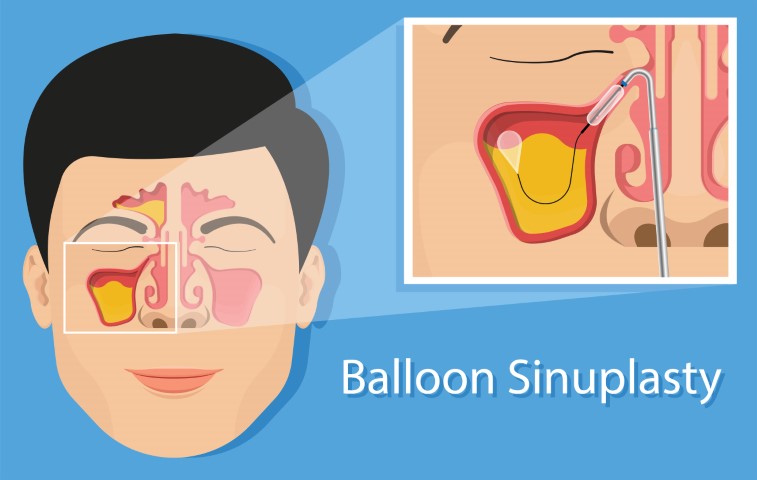The sinuses are the system connected to the hollow cavities of the skull. Sinusitis is an inflammation or infection of the mucous membranes that line the sinuses. It swells when the mucous membrane gets inflamed. There are two types of sinusitis, Acute which is short-term and Chronic which is long-term. Acute sinusitis lasts for a short term that is typically less than four weeks, usually a part of cold or other respiratory illnesses. Whereas chronic sinusitis lasts more than 12 weeks or is recurring even after taking antibiotics. There are also surgery methods to treat chronic sinusitis such as Septoplasty, Turbinate Reduction, Functional Rhinoplasty, Endoscopic surgery and Balloon Sinuplasty. Amongst these, the most straightforward surgery is Balloon Sinuplasty.
So, what is Balloon Sinuplasty?
Balloon Sinuplasty is a new technique in sinus surgery, instead of using endoscopic instruments, surgeons use balloons to dilate the sinus opening. This technique is very much similar to angioplasty that uses a balloon to open blocked blood vessels. This method causes minimal trauma to the surrounding tissue and preserves the natural sinus opening. Balloon Sinuplasty is recommended for people with chronic sinusitis. As the surgery is straightforward and has minimal reported complications. There is no cutting or removal of bone or tissue involved. But it is a sinus surgery and carries the same type of risk that other sinus surgeries do.
Is it safe?
Balloon Sinuplasty is considered safe and effective. It is one of the most common types of sinus surgery. This is because of the high popularity associated with a high success rate and low risks of complication.
Some benefits associated with Balloon Sinuplasty are short clinic visit or hospital stay, fewer post-operative appointments, reduced risk of scarring, minimal risk of unintentional tissue damage, low risk of bleeding and low risk of post-operative infection. Balloon Sinuplasty is also known to have minor symptoms, but this resolves shortly after surgery.
Risks of Balloon Sinuplasty
All forms of surgery have some risks. Intracranial complications can be one of the great potential complications. In such cases, the connection between the brain and the nose is affected during the surgery and there is a possibility of brain fluids leaking into your nose. This complication is very rare. The chance of a change in the appearance of your nose can be noticed. Also, sometimes the swelling takes longer to subside.



How long does it take to heal and recover after Sinuplasty?
Balloon sinuplasty or balloon catheter dilation surgery is a relatively new surgery. It is either performed in a hospital or in a private clinic of an ENT specialist. During this procedure, the doctor will insert a very slim and flexible balloon catheter into your sinus passage and the balloon is then inflated to expand the opening of the sinus. Your doctor will flush out all the pus and mucus in the sinus cavity with a saline solution. Once the process is complete, they will then remove the balloon which will leave the sinus passage wide and the sinus free of build-up pressure. Sinuplasty has a short recovery period in addition to the advantages of safety and immediate results. After Sinuplasty a patient can typically go home after a few hours and return to their regular activities. But it is advised to avoid any strenuous activities. In a week after the surgery, you might see some discharge or bloody drainage coming from your nasal. But it is nothing to be worried about as it is normal. You may even experience swelling or nasal congestion, it heals and you will be free of these symptoms within 5-7 days. After the surgery, your doctor will tell you not to blow your nose for at least 24 hours and prescribe you antibiotics to discourage the infection. Sleep with your head elevated to relieve drainage discomfort. Be careful and aware of how you feel, take it easy for the first week after the surgery.
The fastest road to recovery is to follow proper instructions from your doctor. Get in touch with your doctor before taking any over-the-counter medication. They will also prescribe you a saline solution to rinse your nasal passages for three to seven days after the procedure. It will help keep your sinuses lubricated and promotes healing.



DO’S and DONT to be followed after the procedure.
Every surgery comes with a set of Do’s and Don’ts. This list will help you properly without much trouble.
Do’s:
- You should elevate your head while sleeping.
- Take the prescribed steroids or antibiotics given to you by your doctor.
- Rinse your nasal passage with saline spray.
- Allow time to rest, for the first 24-48 hours take it easy.
Don’ts:
- Avoid blowing your nose: As the nose is in a delicate state.
- Exercise moderately, walking is preferable.
- Avoid strenuous activity.
With all of this, allow yourself to recover completely and follow up with your doctor regularly. Balloon sinuplasty has been shown to be effective in improving quality of life but it is not always suitable for everyone. So, consult your doctor and know the best option available for you.





Comments are closed.